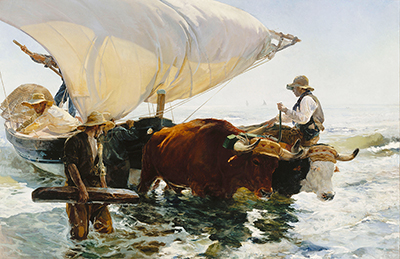The Return from Fishing is arguably one of Joaquin Sorolla's finest pieces of artwork from his famous collection which embroiders an impressionist style of art giving life to the painting.
It's one of his paintings that depicts the daily lives of ordinary and contemporary people in a social gathering going by their daily routines thus bringing out a social theme. It also represents an old and specific Spanish tradition of naturalistic painting which has a huge psychological presence and which light also plays a very key role. Return from Fishing was created in the year 1894 in Valencia Spain in an impressionist style of painting. The main materials used in the art are oils and canvas two options that vividly and accurately represent an oil painting. This is one of the key paintings in Joaquin Sorolla's development as a painter since its actually one of his first large paintings of a natural subject and also one of his premier Venice beach scenes which has left a lot of people arguing that it might be one of his first pieces of work.
This impressionist style painting accurately and objectively records a visual reality in its more complex and transient effect in the use of light and color. The painting first captures a passing moment of a live natural subject that shows men fishing, and also shows a broader picture of a land and seascape at a beach in Valencia under a beautiful sunny weather. This piece strongly emphasizes the effect of light by use of short, broad, and thick brushstrokes that strongly capture the essence of the object rather than some quickly applied brush strokes. Here the broad strokes follow the direction that the objects take or suggest. for example, the flow of the waves in the water, the moving of the boat towards the beach, and the movement of the cattle being pulled towards the shores. This way it not only captures the gesture of the object but covers their complete forms and movement too.
In general the painting demonstrates one very thick and blotting technique that captures a luminous vibrancy of the mediterranean sea, the sky, and the open sails in a windy beach environment. One very notable and odd feature of this painting is the actual use of cattle in the fishing process. Here we see Valencia fishermen coming out of the sea at the end of a day's tough work with their boat seemingly overwhelmed with the weight of fish and so they bring out oxen to help in pulling out the boat on to the shores. While observing the impressionist esthetic in most of his works, it is indeed very evident that he draws much of his inspiration from the study of Velazquez and Goya who have influenced much of his designs and subjects. He has and continues to inspire his students and other professional painters all around the world from his sketches, outdoor paintings, and the impressionist style which brought him a lot of perspective and uniqueness in the field of painting as he grew in his creative development.
Related Works
Some of the most notable and famous artistic examples of his works which have been preserved and exist in galleries around the world include:
- The Grape Harvest (1896)
- Children at the Beach (1899)
- Lighthouse Walk at Biarritz (1906)
- Monte Ullia, San Sebastian (1909)
- Castle of La Mota, Medina del Campo
- Ibiza House (1919)
- White Rose from The House Garden
- Looking for Shellfish (1919)
- The Tunny Catch (1919)
- The Smugglers (1919)
One of the main features that all these paintings share is the fact that he only painted what he actually saw.




